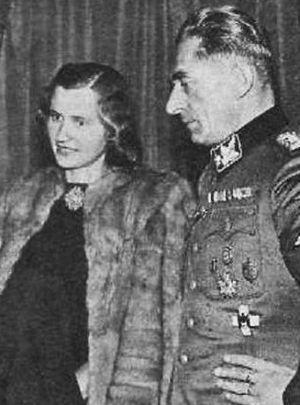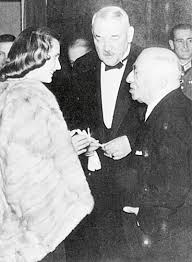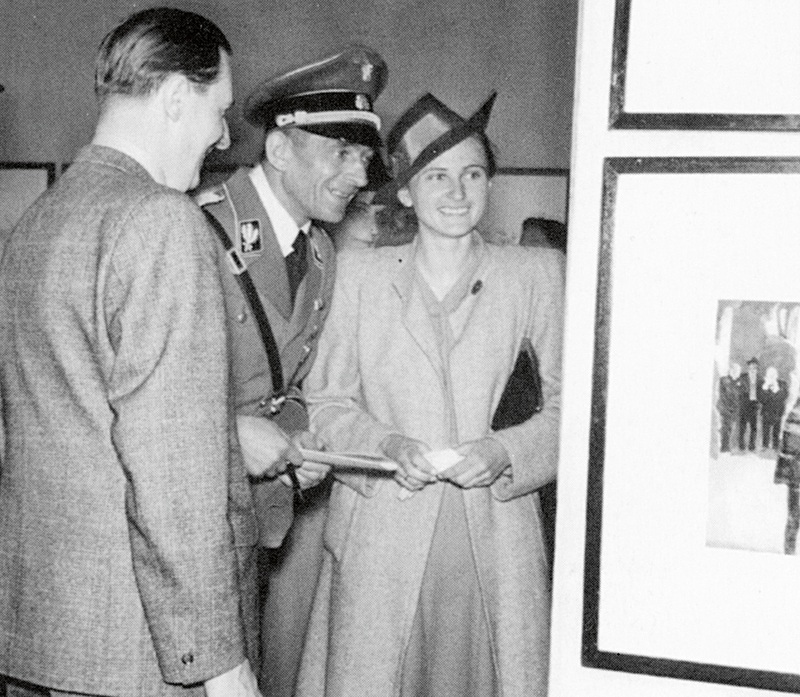
Karl Frank was responsible for the death of tens of thousands of innocent people in Czechoslovakia during the Nazi occupation. He oversaw the slaughter of innocent civilians after the assasination of Heydrich in 1942. The movie “Anthrodoid” released in 2016 was named after “Operation Anthropoid”. Operation Anthropoid was the code name for the assassination during World War II of Schutzstaffel (SS)-Obergruppenführer and General der Polizei Reinhard Heydrich, head of the Reichssicherheitshauptamt (Reich Main Security Office, RSHA), the combined security services of Nazi Germany, and acting Reichsprotektor of the Protectorate of Bohemia and Moravia.
The wife of Frank was said to have been elegant and beautiful, a decent person by all accounts. How then could someone have lived with such a monster as the Nazi Karl Frank.
The following article appeared about Dr. Karol Frank in the Czech publication “Novinky”.
The Secret Disappearance of Karol Franková
18. 1. 2016, \
Miroslav Šiška, Právo in Novinky.cz translated by David Grunwald
https://www.novinky.cz/zena/styl/clanek/tajemstvi-zmizele-karoly-frankove-336969 (Czech)
The photographs show a very beautiful woman. The second wife of K. H. Frank, she fled together with their three small children on the morning of May 9, 1945 in a column of four cars travelling from insurgent Prague to the West.[1]

The almighty ruler in the Protectorate of Bohemia and Moravia, Karl Hermann Frank, literally decided to flee the city at the last minute. He used an agreement with the insurgent Czech National Council and with the headquarters of the German troops with the free passage of German troops and with his entourage he wedged himself into the crowds of soldiers and civilians rolling towards Pilsen.
They left in the dark. Frank sat in an eight-cylinder Mercedes with Adjutant Hoffmann and Commander of Protection Voss, followed by Karol in the third car with the children and a babysitter. Around one o’clock in the afternoon, the column arrived in Rokycany. Frank was recognized in a car in the square. People pounded on the hood, threatening him with clenched fists, and a few stones fell on the car.
She hid in the Hospital
He was forced to disembark from the vehicle and subsequently arrested and transported to the headquarters of the US 9th Infantry Regiment. After a few hours, he was transferred to Pilsen and then to the American prison camp in Wiesbaden. At the command of the Czech government, he was transported to Prague on August 4, 1945 and brought to justice in March 1946.
During the trial, he said: “the Czechs were constantly threatening me in Rokycany, but under the American flag I was transported to Pilsen to the American headquarters.” They said that they were following me and that I did not have to worry about them.”

Frank did not realize that the Americans had no interest in his wife and would probably give her to the Czechoslovaks. However, according to the contemporary press, the whole matter was not so straightforward.
In the Pilsen newspaper “Nový den” we read on May 17, 1945: “Frank’s 31-year-old wife managed to escape to Stod and hide there in a hospital. However, she was also caught and arrested yesterday by the Czech revolutionary authorities, which took her to the Pilsen prison.”
Apparently, Karol (either with or without children) managed to get from Rokycany Square to the nearby town of Stod in some way. In any case, after its release to Czech authorities she had been transferred to Prague to the police headquarters in Bartolomějská Street. The children stayed in a Pilsen deportation camp, where they were taken in by other German women and transported to Germany.
Medic in the Last Year
Karola Blaschkeová was born in August 1913 in Most, North Bohemia, into a well-to-do German family. Her father was a director at one of the coal mines. It is commonly said that she spoke Czech very well, probably thanks to her Czech mother.
There are all kinds of conjectures about the cause and circumstances of Karol Frank’s stay in the Soviet Union.
She met the then-prominent politician and Karel Hermann Frank, who was fifteen years older, in Prague in the autumn of 1938. She studied at the Faculty of Medicine of the German University for the last year, and Frank – as Deputy Imperial Commissioner for the Sudetenland – came to Prague several times from Liberec, where he moved from western Bohemia after the occupation of the Sudetenland.
He later stated that during these trips to the capital of the so-called second Czech-Slovak Republic, “he met with his collaborator and future brother-in-law Dr. Blaschke “, who later became head of the provincial office.[2]

At that time, Frank’s first marriage to the daughter of a Karlovy Vary tailor, with whom he had sons Harald (1927) and Gerhard (1932), was failing.
After the war, he said in court: “My first wife was Anna, née Müller, born in May 1898. It was an unfortunate marriage, so there was a divorce in February 1940. I have not lived with my wife since 1933, because I was so busy in political life that I did not care for her. In the court ruling, the marriage was ended by my fault.”
The Most Elegant of German Mistresses
Two months after the divorce, on April 14, 1940, Frank married Dr. Karol Blaschkeová and brought her to a luxurious villa in Prague-Bubeneč (today 11 Nad Zátorkou Street). The newlywed apparently worked for a short time as a doctor at the internal clinic of the General Hospital in Prague on Charles Square, before their daughter Edda was born in August 1941. Exactly a year later, his son Wolf Dietrich was born and in March 1944 his second daughter Holle Sigfried.
According to contemporary sources, Karola Franková had a decent reputation and was described as a pleasant woman. Although she was a member of the Nazi Party (NSDAP), she was not involved in politics. She often accompanied her husband to various social events when she was not pregnant.
She was first captured by photographers in the early 1940s on the occasion of the visit of the Reich Minister of Propaganda, Joseph Goebbels, to the film studios in Barrandov.
It is also clear from other photographs and memories of the witnesses that Karola was a charming lady. “Among other ‘German mistresses’, she excelled in youth, beauty and education,” notes Miroslava Burianová on the pages of her book “Fashion in the Streets of the Protectorate.”
“For large social events, she chose beautiful robe prints (printed silk), even though she was in the final stage of pregnancy. Her age, a slender figure and an attractive face certainly played a role, but if we were looking for the most elegant woman among the wives of politicians, she would certainly be Karola Franková.”
From Prague to Lubyanka
And it seems that her appearance in society “influenced” her other destinies as well. Sometime around May 20, 1945, when she found herself in custody at the police headquarters in Prague and was interrogated. A certain senior officer of the Red Army allegedly appeared the next day in Bartolomějská.
It is said that Karola Franková “caught his eye”, so he asked her to work in a hotel in Malá Strana, where senior Red Army officials lived at the time.

According to another version, she went there to work for several months. It was alleged that it was not until May 1946 that the Soviet authorities informed the Czechoslovak Ministry of Foreign Affairs that she was in Moscow and asked if they needed her. They received an answer that the Extraordinary People’s Court did not initiate any criminal proceedings against Dr. Karola Franková and “that they were not interested in her”.
In his book about Prague (published in Czech in 1997), Rudolf Ströbinger published an undated memory of Karol Franková: “After leaving Bartolomějská Street, I soon realized that I was in the hands of the Soviet military intelligence service. Then, at the end of May, I was transported to a field airport near Dresden. There were several German officers in the large tent, one of them the rank of general. We had to wait a few hours. Then the plane was ready to take off. The destination was Moscow, Lubyanka Prison.”
K. H. Frank had known of his wife since his arrest in Rokycany Square. Later, while in custody at Pankrác, he asked General Josef Bartík (who was conducting the investigation against Frank and other war criminals) if his wife could visit him. The general allegedly promised him this, but their meeting never took place. Apparently it was no longer in the general’s ability to arrange it…
After a verdict, Frank’s lawyer Dr. Kamill Resler wrote a detailed report on the last three hours of his client’s life, which he called The Execution of K. H. It is clear from one passage in this report that Frank knew shortly before the execution that his wife was in Moscow.
A Soviet Secret Service Agent?
There are all sorts of conjectures about the cause and circumstances of Karol Frank’s stay in the Soviet Union, sometimes with unbelievable parameters. According to one of these versions, she was allegedly a member of the Soviet intelligence service since 1937 in the rank of lieutenant and was given the task of marrying K. H. Frank. After being detained by the American army in Rokycany, she allegedly declared that she was an Allied officer and asked that she be handed over to the Red Army.
“Due to the fact that she was an agent of the Soviet intelligence service,” Václav Miko, for example, argues on the pages of his book Czech Mistresses of the Nazis (published by Petrklíč, 2015), “she was not tried in Czechoslovakia, but transferred to the Soviet Union. She was sentenced to 12 years in prison for illegal cooperation with British intelligence services. She spent more than a year in Lubyanka Prison and the rest of her sentence in the gulag in Kazakhstan.”

Other versions, which are also unsubstantiated by facts, speak of the fact that she was a double agent (she allegedly cooperated with MI6 and SOE), and she was sentenced to ten years of labor camp for this “unrecorded and thus unauthorized cooperation.”
The above-mentioned R. Ströbinger wrote in his book “Poker in Prague”, “When the head of the camp found out that she was a doctor, he entrusted her with the medical care of the prisoners.”
She Found All Her Children
The reality was more prosaic. Karola Franková apparently really liked a Soviet officer, perhaps a general, who made sure that she was transported to the Soviet Union at the end of May 1945.
How and where did she live then? Was she tried? This has not yet been reliably clarified. The only thing that is certain is that she did not get out of the Soviet Union until ten years later in 1955, on the basis of an agreement between the USSR and Germany on the transfer of prisoners of war.
At the age of forty-two, she left for what was then West Germany and allegedly only then learned of the execution of her husband in May 1946. It is often said that she searched for her three children for four more years before gradually finding them in foster families.
However, according to one of our reporters, who is well acquainted with the story of Karol Frank, she actually managed to do it within a few weeks with the help of her family.
In the 1960s, Karola Franková was habilitated and later worked until her retirement as a doctor in a city in Westphalia. She is reported to have died in 1982 (in Germany), but according to another source, only after 1989, when she was said to have been able to visit her native country.
Additional Resources
The new movie “Anthropoid” gives a very good overview of the tension of the Czech occupation and the cost of killing SS Commander Reinhardt Heydrich born by innocent civilians. The assassins were killed in firefight at St Cyril and Methodius Cathedral. Bishop Gorazd and church priests were arrested and executed as well as an estimated 13,000 arrested and interrogated; and an estimated 5,000 executed. The towns of Lidice and Ležáky were destroyed, its citizens executed or imprisoned.
The Frank’s three children:
Edda, born August 16, 1941
Holle, born March 8, 1944
Wolf-Dietrich, born August 20, 1942
[1] Karl Hermann Frank (24 January 1898 – 22 May 1946) was a prominent Sudeten German Nazi official in the Protectorate of Bohemia and Moravia prior to and during World War II. Attaining the rank of Obergruppenführer, he was in command of the Nazi police apparatus in the Protectorate, including the Gestapo, the SD, and the Kripo. After the war, Frank was tried, convicted and executed by hanging for his role in organizing the massacres of the people of the Czech villages of Lidice and Ležáky.
[2] Not to be confused with Hitler’s dentist. Hugo Johannes Blaschke (14 November 1881 – 6 December 1959) was a German dental surgeon notable for being Adolf Hitler’s personal dentist from 1933 to April 1945 and for being the chief dentist on the staff of Reichsführer-SS Heinrich Himmler.

2 thoughts on “The Secret Disappearance of Karol Franková”